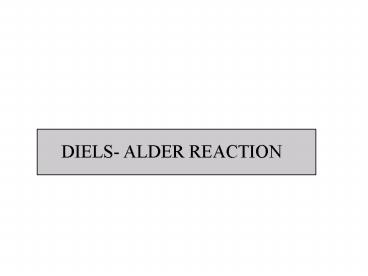DIELS ALDER REACTION - PowerPoint PPT Presentation
1 / 22
Title:
DIELS ALDER REACTION
Description:
photolysis: :pyrolysis. easily decomposed. by light or heat. nitrogen is a very. thermodynamically ... photolysis. D. D. pyrolysis. trans. trans. cis. cis ... – PowerPoint PPT presentation
Number of Views:2073
Avg rating:5.0/5.0
Title: DIELS ALDER REACTION
1
DIELS- ALDER REACTION
2
The Diels-Alder Reaction
concerted
ring-forming reaction
three pairs of electrons move at one time
- diene dienophile
cyclohexene
gain of bond order
NOTE
loss of bond order
3
THE DIENE MUST BE ABLE TO ADOPT THE S-CIS
CONFORMATION
rotate
reacts
s-trans conformation
s-cis conformation
does not react
reacts normally
4
DIELS-ALDER REACTION
HOMO
(diene)
The reaction is concerted - all of the
orbitals are aligned in a 6-ring.
2
The HOMO of the diene donates elec- trons into
the LUMO of the dienophile.
1
LUMO
(dienophile)
5
BUTADIENE
ETHYLENE
p4
The HOMO of the diene donates electrons into the
LUMO of the dienophile.
p3
LUMO
HOMO
p2
p
p
p1
6
EXAMPLE - WITH ELECTRONIC FACTORS
pull
push
D
Diene
Dienophile
A Cyclohexene
Works best if the dienophile has
electron-withdrawing groups, and the diene
has electron-donating groups.
The HOMO of the diene donates PUSHES electrons
into the LUMO of the dieno- phile PULLS.
7
FORMATION OF A BICYCLIC COMPOUND
D
8
THE REACTION IS USUALLY STEREOSELECTIVE
endo
exo
The endo product is usually preferred.
It has been suggested that the pi systems like to
establish maximum overlap during the reaction.
9
MORE DIELS-ALDER REACTIONS
D
D
10
Retrosynthesis
11
ACETYLENES (ALKYNES)
If the dienophile is an alkyne a cyclohexadiene
is formed.
12
CARBENES - CYCLOPROPANES
13
a-ELIMINATIONS
REVIEW
( also covered in Section 9.13 )
Alkyl halides which have no b-hydrogens will
undergo a-elimination to give carbenes.
b-hydrogen
no b-hydrogens in these groups
a
a
b
a-hydrogen
E1 or E2
carbene
-
alkene
14
MECHANISM
Some halides without a-hydrogen atoms
Step 1
fast
-
Step 2
-
..
slow
..
-
carbene
is a strong base such as NaOH, NaOEt, KOH, NaNH2,
or nBuLi
15
CARBENES ARE ELECTRON-DEFICIENT
Carbenes are neutral, no charge, but have an
incomplete octet.
They react with alkenes (electron donors) to form
cyclopropanes.
carbene
R
R
syn addition
cis
cis
R
R
a cyclopropane
The reaction is thought to be concerted.
STEPWISE ANALYSIS OF THE CONCERTED REACTION
..
-
16
SOME REACTIONS OF DICHLOROCARBENE
17
SYNTHESIS OF NORCARANE
phenyl sodium
-
-
strong base
ylide
-
-
a -elimination
tetramethylammonium chloride
carbene
norcarane
(bicyclo 4.1.0 heptane
18
explosive if not handled carefully
DIAZOMETHANE
(gas)
UNSTABLE
easily decomposed by light or heat
-
..
..
-
light heat
photolysis
pyrolysis
hn D
nitrogen is a very thermodynamically stable
molecule, and forms readily
nitrogen
methylene
( the specific name for this carbene )
19
DIAZOMETHANE REACTIONS
pyrolysis
D
trans
trans
D
cis
cis
photolysis
hn
20
CARBENOID REACTIONS
21
SIMMONS-SMITH REACTION
a carbenoid reaction
Zn-Cu
Zn-Cu is a zinc-copper couple which is more
reactive than either would be alone. Copper
activates the zinc.
R
R
cis
R
R
cis
concerted
stereospecific
carbenoid reactions give a result as if a carbene
is involved, but it is not.
22
WHY USE THE SIMMONS-SMITH ?
1) not hazardous like diazomethane
2) milder reaction conditions
3) doesnt require strong base like a-elimination
4) fewer side products
5) higher yields
.. what else could you want ?































